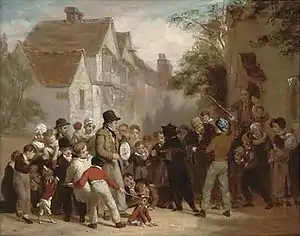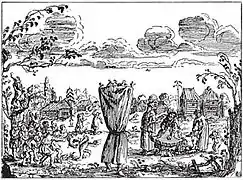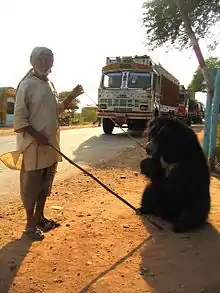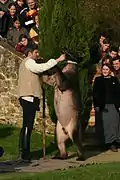Tame bear
A tame bear, often called a dancing bear, is a wild bear captured when young, or born and bred in captivity, and used to entertain people in streets or taverns. Dancing bears were commonplace throughout Europe and Asia from the Middle Ages to the 19th century, and can still be found in the 21st century in some countries.

Dancing bears
History
In Ancient Rome, bears and monkeys were led to dance and perform tricks for the public.[1] Dancing bears were commonplace in the Indian subcontinent for centuries. The last of them were freed in 2009.[2]
In Russia and Siberia, cubs were for centuries captured for being used as dancing bears accompanying tavern musicians (skomorokhi), as depicted in the Travels of Adam Olearius.[3] Dancing bears were widespread throughout Europe from the Middle Ages to the 19th century. They were still present on the streets of Spain in 2007,[4] and in Eastern Europe.
Recently, organizations and animal rights activists have worked to outlaw or eliminate tame bears, due to them being seen as cruel and antiquated, citing mistreatment and abuse used in order to train the bears.[5][6]
Gallery
 Engraving with dancing bear from Adam Olearius's Travels, 1647
Engraving with dancing bear from Adam Olearius's Travels, 1647 Bohemian Bear Tamer, 1888 cast by Paul Wayland Bartlett
Bohemian Bear Tamer, 1888 cast by Paul Wayland Bartlett A dancing bear in Pushkar, India, 2003
A dancing bear in Pushkar, India, 2003 Dancing bear in France, 2007
Dancing bear in France, 2007
In popular culture
- The concept has entered into the lexicon in the form of the common proverb; "The marvel is not that the bear dances well, but that the bear dances at all."
- Randy Newman's song "Simon Smith and the Amazing Dancing Bear" is about a humble young man who entertains high society with his tame bear.
- A dancing bear features at the end of Cormac McCarthy’s 1985 Western novel Blood Meridian and is shot in a saloon by a drunkard.
- In the Simpsons episode “Marge on the Lam,” Homer Simpson and Lenny Leonard both misremember ballet as “the bear in the little car.”
- Rafi Zabor's novel The Bear Comes Home is a fictional story about a bear trained to play jazz saxophone.
- The Joanna Newsom song “Monkey & Bear” concerns a bear named Ursala who is deceived by the Monkey into dancing for children.
- The animated movie Madagascar 3: Europe's Most Wanted features a bear named Sonya who is trained to ride a unicycle. Sonya is considerably more animalistic than the other anthropomorphic animals in the film.
References
- Pelin Tünaydın, "Pawing through the History of Bear Dancing in Europe" (PDF), Frühneuzeit-Info
- "Last Indian dancing bear set free". BBC News. 18 December 2009. Retrieved 4 January 2017.
- Findeizen, Nikolai (2008). History of Music in Russia from Antiquity to 1800, Vol. 1: From Antiquity to the Beginning of the Eighteenth Century. Indiana University Press. p. 201. ISBN 978-0-253-02637-8.
- Neale, Adam (16 October 2007). "Dancing bears in Spain cause public outcry". The Olive Press. Retrieved 4 January 2017.
- "Dancing bears – Bear Conservation". Retrieved 2020-11-09.
- "Traveling Bear Shows: Abuse and Neglect On Tour". PETA. 2017-10-30. Retrieved 2020-11-09.
